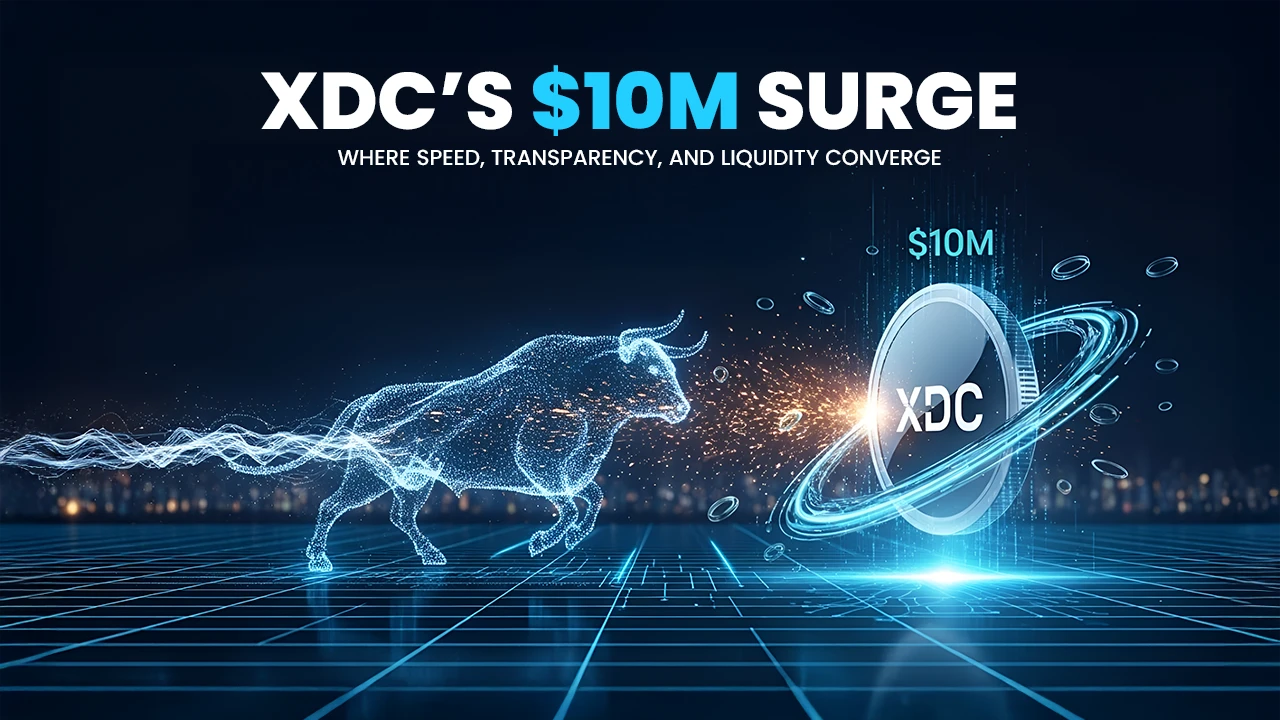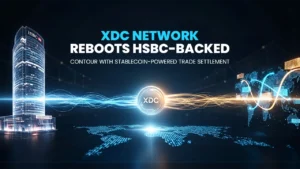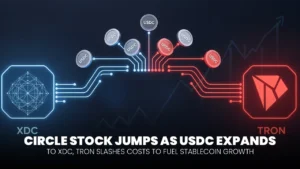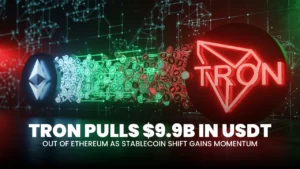XDC Network Unveils $10M “Surge”, Brings Real-Time Transparency to DeFi

XDC Network has launched “Surge,” a $10 million incentives program designed to deepen liquidity across its decentralized finance stack and concentrate rewards where they can lift market depth the most. The campaign tracks and pays contributors in near real time through a new Engagement Hub that integrates Merkl’s incentive rails, a system already used across many chains to run transparent, rules-based payouts.
- Surge: How The Incentives Work
- The Strategic Rationale Of XDC Network Behind $10 Million Investment
- Why DPoS Matters to Liquidity Design
- Liquidity Targets, Baselines, And Measurement
- Catalysts Around the Edges
- Market View: How Investors Can Read the Program
- Key XDC DeFi Baselines and Program Levers
- Risk Checks Investors Should Watch
- For Investors: A Simple Framework
- Conclusion
- Frequently Asked Questions for XDC’s 10M Surge Program
- What is the Surge program designed to do?
- How does XDC’s Delegated Proof of Stake affect DeFi activity?
- Which metrics best show whether Surge is working?
- Is this only about DeFi, or does it tie to enterprise goals?
- What protects against opaque or misallocated rewards?
- Glossary of Key Terms
The move arrives as the network leans into its enterprise positioning, tokenization agenda, and low-cost Delegated Proof of Stake (DPoS) mechanism, positioning throughput and finality as a practical edge for market-makers and stablecoin pools.
XDC Network says the first two-month “Epoch 001” will direct rewards to core liquidity venues, with program dashboards surfacing pool-level APRs and distribution math. The Engagement Hub centralizes that data and points users to eligible pools, an approach meant to reduce reward opacity that often clouds cross-chain campaigns.
XDC’ Network’s own material frames the hub as a single front door for community contributions that can be audited, a design choice meant to limit confusion about who earned what and why. That operational clarity is as much the story as the headline number.
“The XDC Engagement Hub is LIVE,” the official account posted as the program tools went public, underscoring a pivot toward transparent on-chain incentives rather than ad-hoc grants.
Surge: How The Incentives Work
The Surge program sets aside $10 million to reward liquidity providers in XDC and liquid-staked XDC, with allocations tied to predefined pools and actions across integrated DeFi protocols. Merkl’s infrastructure handles the logic and scheduling of rewards. The system reads on-chain activity, applies campaign rules, and distributes tokens with an audit trail.
Many chains use Merkl for Uniswap-style concentrated liquidity and lending incentives, so adopting a familiar playbook reduces friction for professional LPs. The first epoch prioritizes deep, stable pools that improve execution quality for traders and treasuries.
XDC’s Engagement Hub sits on top, exposing pool APRs, eligible assets, and point systems in one place. That unification matters because multi-protocol incentives fail when users cannot see the whole field. The hub reduces discovery costs, while Merkl standardizes distribution. This type of rails-plus-dashboard model has become a best practice for serious liquidity drives because it minimizes the deadweight loss of confusion and misaligned rewards.
XDC Network Launches $10 Million “Surge” Program to Boost DeFi Liquidity
XDC Network has unveiled XDC Surge – a $10 million strategic incentive program designed to accelerate decentralized finance (DeFi) growth and liquidity across the ecosystem.The initiative rewards liquidity… pic.twitter.com/s68mm0PMeY
— XDC Network (@XDCNetwork) October 22, 2025
The Strategic Rationale Of XDC Network Behind $10 Million Investment
The headline number is meaningful for a chain where core DeFi metrics are still building. XDC’s current stablecoin float sits in the tens of millions rather than the billions. Daily DEX volume is measured in low single-digit millions, and fee capture remains modest, which means even a targeted set of bounties can visibly move spreads and book depth. Surge is a test of whether a coordinated program can pull more stablecoin inventory, compress slippage, and tighten price discovery across pairs that matter for users and enterprise pilots.
The ecosystem context adds weight. XDC’s pitch centers on tokenized trade finance, where payment certainty and predictable fees matter. Native USDC and standards like Circle’s CCTP are lining up to reduce bridge friction, while the network’s accelerators with corporate platforms aim to populate the pipeline with real-world asset projects. Liquidity is the missing connective tissue between that enterprise stack and everyday on-chain users. Surge tries to supply it and, crucially, measure it.
ALSO READ: Sui ETF Back in Limelight as Cboe Awaits SEC Decision on Canary ETF
Why DPoS Matters to Liquidity Design
XDC Network’s consensus is Delegated Proof of Stake (DPoS) that targets high throughput and low energy draw. Validators are elected, block production is concentrated for speed, and the protocol is EVM-compatible, which makes porting DeFi playbooks straightforward. For market-makers, settlement speed and fee stability are operational variables. A DPoS mechanism that clears trades quickly and cheaply can help LPs rebalance positions more often, hedge basis risk faster, and keep net yields intact after fees. Surge attempts to subsidize the early phase while participants test whether XDPoS economics support persistent market-making without permanent handouts.
The contrast is instructive. Proof-of-Work chains may offer deep liquidity because of scale, yet their fees and latencies can inject basis noise into LP strategies. Some Proof-of-Stake chains deliver speed but struggle with durable activity after incentives fade. Delegated Proof of Stake is not a silver bullet, yet it is a credible design for high-frequency, low-fee environments when governance is healthy and validator sets are aligned. That is the thesis XDC wants to prove in production.
Liquidity Targets, Baselines, And Measurement
The program will be judged on measurable outcomes. Before Surge, XDC DeFi showed modest TVL and limited protocol revenue compared with top-10 chains. The network’s stablecoin base was dominated by USDC share, and DEX volume hovered around low millions per day. The Engagement Hub’s value is that it lets observers watch movement rather than marketing. If stablecoin market cap on chain rises and pool depth thickens on priority pairs, spreads should compress, and volatility around trades should fall. That is how investors can separate signals from subsidies.
The use of Merkl also implies certain discipline. Campaign rules can reward not just raw TVL, but useful TVL, including incentives tuned to concentrated liquidity ranges or specific pairings that matter for routing. This lets XDC direct dollars at friction points, like thin stable pools or long-tail assets that need initial depth to become usable. Over time, the best-performing pools can maintain smaller ongoing rewards while still keeping depth, a path toward sustainable emissions.
ALSO READ: TRON Staking Goes Live on Ledger Live, Self-Custody Rewards Finally One Tap Away
Catalysts Around the Edges
“Surge” is not launching in isolation. The network is seeing a steady cadence of enterprise-facing initiatives. Plug and Play has run XDC-branded accelerators to attract real-world asset projects. Community updates point to native USDC and messaging that favors trade finance rails with transparent collateral logic. These pieces matter because liquidity incentives work best when they meet organic demand, not just mercenary capital. A credible pipeline of tokenized assets and enterprise flows can backstop pools after the first epochs, letting LPs recycle earnings into positions that continue to pay from fees rather than subsidies.
The Engagement Hub also formalizes community contributions outside pure LPing. If the same dashboard can track audits, developer tools, and support tasks with clear payout logic, then the ecosystem can reward non-financial efforts that make DeFi safer and easier to use. A clean, unified ledger of contributions is hard to maintain across forums and chats. Automating it reduces disputes and keeps builders focused on shipping.
Market View: How Investors Can Read the Program
Investors do not need to guess. They can monitor a handful of concrete metrics to evaluate whether Surge is working. First, look at the daily DEX volume and the weekly change. Second, watch the stablecoin market cap on the chain, including USDC share as the base currency for most DeFi. Third, track fees paid and protocol revenue, small today but directionally important. Finally, examine depth on prioritized pairs to see whether spreads compress during normal and stressed periods. DefiLlama’s dashboards make much of this observable. If those lines slope up while incentives taper, durability improves.
The second lens is program design. If rewards migrate toward pools that demonstrably improve routing and reduce user slippage, governance is working. If rewards chase vanity metrics without moving execution quality, emissions are being wasted. Merkl’s rules engine allows for sophistication here, including time-weighted, range-aware bonuses that align with how concentrated liquidity actually functions on modern DEXs. Program managers should publish those rules clearly on the Engagement Hub so the market can judge alignment.
ALSO READ: Sui DEX Volume Hits ATH Amid Typus Exploit, SEC’s Green Signal to YLDS
Key XDC DeFi Baselines and Program Levers
| Metric or Lever | Current Context on XDC | What Surge Targets |
| Stablecoin market cap on chain | Roughly tens of millions, dominated by USDC share | Higher float to support tighter stables pools and routing depth |
| DEX volume | About $1–5 million per day, with weekly swings | Higher and steadier throughput across priority pairs |
| Fees paid | Hundreds to low thousands per day | Rising fee capture as a by-product of deeper markets |
| Incentive rails | Merkl engine is widely used by DeFi protocols | Transparent, rules-based distribution and auditable logs |
| Program visibility | New Engagement Hub centralizes data | Single interface for pools, APRs, and reward criteria |
| Consensus design | XDPoS Delegated Proof of Stake, EVM-compatible | Convert fast finality and low fees into durable LP yields |
Sources: DefiLlama chain dashboard, XDC Engagement Hub announcements, Merkl documentation, XDC technical specs. (defillama.com)
Risk Checks Investors Should Watch
Incentive programs can pull mercenary capital. That is not a sin if the design extracts lasting benefits. The risk is a cliff when rewards pause. Investors should watch how depth persists between epochs, and whether spreads remain tight during volatility. They should also watch governance responsiveness. If the program rotates rewards toward pools that show clear volume and fee growth, it signals discipline. If rewards linger where they fail to change user outcomes, emissions become a tax rather than a catalyst. Merkl’s programmable campaigns can help avoid that trap, but only if managers apply the data.
Regulatory clarity around tokenized trade assets remains a moving target across jurisdictions. That context shapes the pace of enterprise onboarding, which in turn affects organic demand for stablecoin rails and liquidity pairs. The presence of native USDC on XDC can reduce bridge risk and improve capital efficiency, but participants will still look for clear legal frameworks around tokenized receivables and invoices. These are execution risks, not thesis killers, yet they will dictate how quickly incentives translate into real usage.
For Investors: A Simple Framework
Treat Surge as a three-part test. First, does liquidity deepen where users need it most? Second, do fees and volumes rise in a way that outlasts the bonus period? Third, does XDC’s DPoS architecture make LP operations cheaper and faster in practice? If the answer is yes on at least two dimensions, the program is adding value. If it is only emissions without measurable depth, the verdict will be clear on the chain. The good news is that the Engagement Hub makes this evaluation straightforward for anyone willing to read dashboards instead of headlines.
Conclusion
XDC Network’s Surge program blends a sizable capital commitment with the plumbing needed to spend it well. The Engagement Hub centralizes discovery and accountability. Merkl supplies the rails for auditable, rule-driven rewards. The initial epoch targets the basic ingredient of any on-chain economy: stable and deep pools that lower slippage and invite volume.
The network’s Delegated Proof of Stake architecture provides the performance profile to keep LP operations cheap and responsive, a claim that markets can verify by watching spreads, fees, and depth over time. If these metrics improve and hold, the $10 million will look like a catalyst rather than a subsidy. If they fade when rewards pause, the dashboards will show that too. Either way, the data will speak, and that is the point.
Frequently Asked Questions for XDC’s 10M Surge Program
What is the Surge program designed to do?
It allocates $10 million to reward liquidity providers on specific pools, aiming to increase depth, cut slippage, and raise usable volume across XDC’s DeFi stack. Payouts are automated via Merkl, and progress is visible on the Engagement Hub.
How does XDC’s Delegated Proof of Stake affect DeFi activity?
XDPoS targets fast finality and low fees. For LPs and traders, that means more frequent rebalancing and cheaper hedging, which can lift net yields and execution quality if liquidity is present.
Which metrics best show whether Surge is working?
Watch daily and weekly DEX volume, pool depth on prioritized pairs, stablecoin supply on chain, and fees captured. Sustained gains after an epoch ends signal durability. DefiLlama tracks many of these numbers.
Is this only about DeFi, or does it tie to enterprise goals?
It ties directly to enterprise tokenization ambitions. Deeper stables and tighter spreads help the network support trade finance pilots and RWA flows, especially if native USDC ramps on chain.
What protects against opaque or misallocated rewards?
Merkl’s rules and the Engagement Hub’s public dashboards improve transparency. The market can verify distribution, measure outcomes, and pressure managers to rotate incentives toward what works.
Glossary of Key Terms
- DPoS: Delegated Proof of Stake, a consensus design with elected validators optimized for speed and low fees.
- XDPoS: XDC’s variant of DPoS, tailored for high throughput and energy efficiency.
- Engagement Hub: XDC’s portal for campaign discovery, rewards, and on-chain contribution tracking.
- Merkl: An incentives distribution platform that automates transparent on-chain payouts across many chains.
- Epoch: A defined time window for a rewards campaign, used to measure and adjust incentives.
- TVL: Total Value Locked, a common DeFi metric for capital deposited in protocols.
- CCTP: Circle’s Cross-Chain Transfer Protocol for native USDC movement across chains.
- Stablecoin Float: The total stablecoin supply resident on a given chain.
- Concentrated Liquidity: DEX pools where LPs supply liquidity within chosen price ranges to increase capital efficiency.
- RWA: Real-world assets, such as invoices or receivables, tokenized on chain for financing or settlement.




